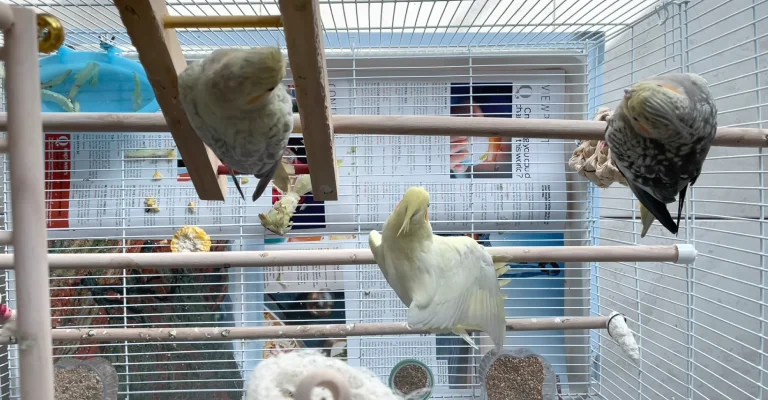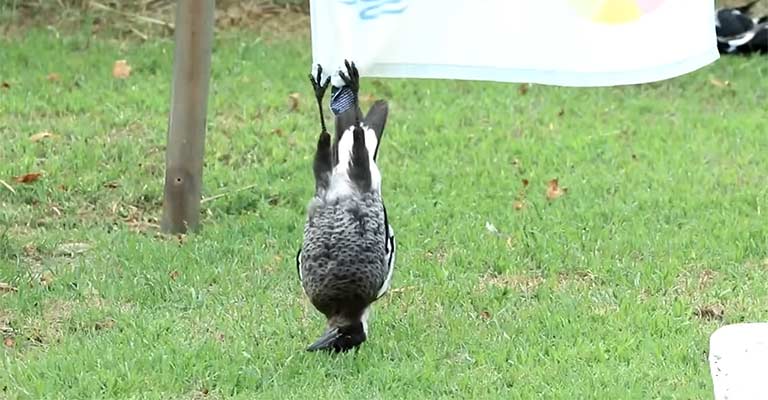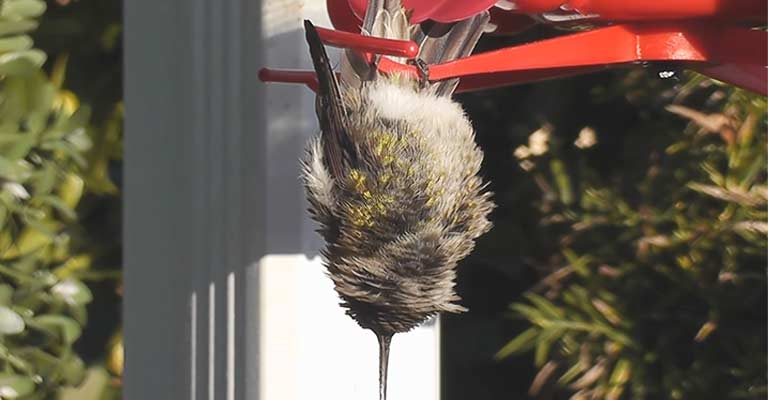The sight of a bird hanging upside down and spreading its wings is a fascinating yet curious behavior that captures the attention of bird enthusiasts and pet owners alike.
This acrobatic display, often observed in various avian species, raises questions about its meaning and significance in the bird’s world. From playful expressions to potential health-related signals, the reasons behind this behavior are diverse and intriguing.
This exploration into why does my bird hang upside down and spreads his wings aims to shed light on the multifaceted nature of avian behavior.
Understanding the motivations behind this upside-down spectacle contributes to the holistic care and appreciation of our feathered companions, fostering a deeper connection between humans and the captivating world of birds.

Why Does My Bird Hang Upside Down And Spread His Wings?
bird hanging upside down and spreading its wings can be attributed to a few different reasons, mainly related to its natural behavior and instincts:
Here’s why does my bird hang upside down and spread his wings:
Playful Behavior
Birds, especially parrots, are known for their playful antics. Hanging upside down and spreading wings can be a form of play and exploration. It allows them to engage different muscle groups, promoting physical activity and mental stimulation.
If your bird exhibits this behavior in a relaxed manner without signs of distress, it likely indicates a playful and happy disposition.
Stretching and Exercise
Hanging upside down and spreading wings can serve as a form of stretching and exercise for birds. This behavior enables them to stretch their wings, neck, and back muscles, contributing to overall flexibility.
Regular stretching is essential for maintaining a bird’s physical health and preventing stiffness or discomfort.
Mating or Courtship Behavior
In some bird species, such as cockatiels, hanging upside down and spreading wings can be part of courtship or mating behavior. This display is an instinctual way for birds to attract a mate.
If you have a single bird displaying this behavior, it may be expressing its natural instincts, even in the absence of a mate.
Exploration and Curiosity
Hanging upside down allows birds to view their surroundings from a different perspective, satisfying their natural curiosity.
Birds are inquisitive creatures, and exploring their environment in unconventional ways, such as hanging upside down, is a manifestation of their inherent curiosity and intelligence.
Attention-Seeking Behavior
Birds are social animals that crave interaction. Hanging upside down and spreading wings can be a way for them to seek attention from their human companions.
If your bird displays this behavior in your presence, it might be attempting to engage with you or simply seeking acknowledgment and interaction.
Comfort or Relaxation
Some birds find hanging upside down to be a comfortable or relaxing position. This behavior may be a way for them to rest or unwind. If your bird appears calm and content and exhibits no signs of distress while in this position, it is likely expressing a form of relaxation.
Molting or Feather Maintenance
Hanging upside down can facilitate feather maintenance, especially during molting. Birds may use this position to preen and groom hard-to-reach feathers on their wings or body.
Molting can be an uncomfortable process, and assuming this position might provide relief or assistance in managing new feather growth.
While these reasons highlight various natural behaviors, it’s essential to observe your bird’s overall well-being.
If the behavior is sudden, accompanied by signs of distress, or persists for an extended period, consulting with an avian veterinarian is recommended to rule out any potential health issues.
What Does It Mean When You See A Bird Hanging Upside Down?

Seeing a bird hanging upside down can have different meanings depending on the context and the species of the bird
Let’s discuss what does it mean when you see a bird hanging upside down:
Playful Expression
When you observe a bird hanging upside down, it often signifies playfulness. Many bird species, particularly parrots, engage in acrobatic behaviors as a form of amusement.
Hanging upside down allows them to exhibit their agility and enjoy the thrill of unconventional movement. If the bird seems relaxed and playful, it’s likely expressing its joyful and carefree nature.
Exploration and Curiosity
Hanging upside down can be an expression of a bird’s natural curiosity. Birds are inquisitive creatures, and assuming this position allows them to explore their environment from a different perspective.
This behavior may indicate a healthy sense of curiosity and intelligence as the bird navigates its surroundings in a unique way.
Stretching and Exercise
Hanging upside down is a common way for birds to engage in stretching and exercise. This behavior enables them to flex and extend their wings, neck, and leg muscles.
Regular stretching is essential for maintaining a bird’s physical health, preventing muscle stiffness, and promoting overall flexibility.
Mating or Courtship Display
In some bird species, hanging upside down can be a part of courtship or mating behavior. This display is often accompanied by vocalizations, preening, and other behaviors associated with attracting a mate.
If the bird is exhibiting these behaviors, it may be expressing its reproductive instincts, even if there’s no mate present.
Attention-Seeking Gesture
Birds are social animals that crave interaction. Hanging upside down might be a way for a bird to seek attention from its human or avian companions.
If the bird performs this behavior in the presence of others, it could be an attention-seeking gesture, indicating a desire for social interaction and engagement.
Comfort and Relaxation
Some birds find hanging upside down to be a comfortable or relaxing position. This behavior might be a way for them to rest or unwind, especially if they seem calm and content in this posture.
If the bird appears relaxed and exhibits no signs of distress, it may be indicating a preference for this particular position for relaxation.
Feather Maintenance and Molting
Hanging upside down can aid in feather maintenance, particularly during molting. Birds may use this position to preen and groom hard-to-reach feathers on their wings or body.
Molting is a natural process, and assuming this position may provide comfort and assistance in managing new feather growth.
While these interpretations highlight positive and natural behaviors, it’s crucial to be attentive to any sudden changes, signs of distress, or prolonged abnormal behaviors.
If you notice anything concerning, consulting with an avian veterinarian can help ensure your bird’s well-being and rule out any potential health issues.
What Should I Do If I See My Bird Hang Upside Down And Spread His Wings?

Here’s what should you do if I see my bird hang upside down and spread his wings
Observe for Signs of Distress
If you see your bird hanging upside down and spreading its wings, start by carefully observing its behavior. Note if the bird seems distressed or uncomfortable or if there are any signs of labored breathing.
If the behavior appears relaxed and is accompanied by typical playful or exploratory actions, it may not be a cause for immediate concern.
Ensure a Safe Environment
Confirm that the bird’s environment is safe and free from potential hazards. Remove any objects that could pose a threat to the bird while in this position.
Providing a secure and stimulating space encourages natural behaviors without compromising safety.
Offer Social Interaction
Birds often engage in playful behaviors to seek attention or social interaction. Spend quality time with your bird, offering toys, treats, and engaging activities.
Providing mental stimulation can redirect their energy and contribute to a happy and healthy environment.
Check for Signs of Illness
If the hanging upside down behavior is sudden, prolonged, or accompanied by signs of distress, it’s essential to consider potential health issues. Consult with an avian veterinarian to rule out respiratory problems, infections, or other health concerns that may be contributing to the behavior.
Provide Proper Nutrition
Ensure your bird is receiving a well-balanced and nutritious diet appropriate for its species. Nutritional deficiencies can impact a bird’s overall health and behavior.
Consult with a vet to review the bird’s diet and make any necessary adjustments or supplements.
Monitor Molting and Feather Health
If the behavior coincides with molting, observe the bird’s feather health. Hanging upside down can aid in feather maintenance. However, if you notice abnormal feather loss, irritation, or signs of discomfort, consult with a vet to address any potential issues related to molting.
Consult with a Veterinarian
If you remain uncertain about the hanging upside-down behavior or if it persists, seeking professional advice is crucial.
A qualified avian veterinarian can conduct a thorough examination, including diagnostic tests, to identify any underlying health issues and recommend appropriate treatments or behavioral interventions.
Remember that individual bird behaviors can vary, and what might be normal for one bird may not be for another. Regular veterinary check-ups, a well-rounded diet, and a stimulating environment contribute to the overall well-being of your feathered friend.
If in doubt, consulting with an avian professional ensures the best care for your bird’s health and happiness.
FAQs
Why does my bird hang upside down and spread its wings frequently?
Frequent hanging upside down and wing-spreading in birds can signify various things, including playfulness, exploration, and even courtship behavior. Birds, especially parrots, exhibit these acrobatic actions to engage with their environment and express their natural instincts.
Is it normal for a bird to hang upside down and spread its wings?
Yes, it can be normal behavior, particularly in playful and intelligent bird species. Hanging upside down and wing-spreading is often a form of exercise, mental stimulation, or a way for birds to explore their surroundings.
Should I be concerned if my bird hangs upside down for extended periods?
Extended periods of upside-down hanging may warrant attention. While it can be a playful or exploratory behavior, persistent or sudden changes may indicate discomfort or potential health issues.
Does hanging upside down mean my bird is stressed?
Not necessarily. Hanging upside down can be a playful or relaxing behavior. However, if your bird shows signs of distress, such as rapid breathing or other unusual behaviors, stress may be a factor.
Can health issues cause a bird to hang upside down and spread its wings?
Yes, certain health issues, like respiratory problems or discomfort, can manifest in unusual behaviors, including hanging upside down. If this behavior is accompanied by signs of illness, such as lethargy or changes in appetite, consult with an avian veterinarian for a thorough examination and appropriate treatment.
Conclusion
The upside-down hanging and wing-spreading behavior in birds adds a layer of complexity to our understanding of avian communication and well-being.
While it can signify playfulness, curiosity, or even courtship, it’s essential for bird owners to be attuned to their feathered friends’ overall health.
Vigilance for signs of distress, coupled with providing a safe and stimulating environment, ensures a conducive space for birds to express their natural behaviors.
If ever in doubt about the significance of this behavior or its potential implications, seeking guidance from an avian veterinarian guarantees the best care for the bird’s physical and mental health.
This acrobatic display, a testament to the diversity and wonder of avian life, invites us to marvel at the intricacies of our winged companions.